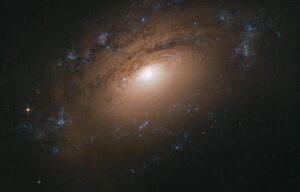Astronomy:NGC 3169
| NGC 3169 | |
|---|---|
 NGC 3169 by Hubble Space Telescope | |
| Observation data (J2000 epoch) | |
| Constellation | Sextans |
| Right ascension | 10h 14m 15.099s[1] |
| Declination | +03° 27′ 58.03″[1] |
| Redshift | +0.004113 ± 0.000017[2] |
| Helio radial velocity | +1,232[3] km/s |
| Distance | 57 Mly (17.43 Mpc)[3] |
| Apparent magnitude (V) | 10.3 |
| Characteristics | |
| Type | SA(s)a pec[4] |
| Apparent size (V) | 4.2′ × 2.9′ |
| Other designations | |
| UGC 5525, PGC 29855[4] | |
NGC 3169 is a spiral galaxy about 75 million light years[3] away in the constellation Sextans. It has the morphological classification SA(s)a pec,[5] which indicates this is a pure, unbarred spiral galaxy with tightly-wound arms and peculiar features.[6] There is an asymmetrical spiral arm and an extended halo around the galaxy.[7] It is a member of the NGC 3166 Group of galaxies, which is a member of the Leo II Groups, a series of galaxies and galaxy clusters strung out from the right edge of the Virgo Supercluster.[8]
This is a LINER 2 galaxy that displays an extended emission of X-rays in the region of the nucleus.[9] A hard X-ray source at the center most likely indicates an active galactic nucleus.[10] The stellar population in the nucleus, and a ring at an angular radius of 6″, shows an age of only one billion years and is generally younger than the surrounding stellar population. This suggests that a burst of star formation took place in the nucleus roughly one billion years ago.[5]
NGC 3169 is located in close physical proximity to NGC 3166, and the two have an estimated separation of around 160 kly (50 kpc). Their interaction is creating a gravitational distortion that has left the disk of NGC 3166 warped.[11] Combined with NGC 3156, the three galaxies form a small group within the larger Leo 1 group. The three are embedded within an extended ring of neutral hydrogen that is centered on NGC 3169.[5]
Supernovae
In 1984, a Type II-L supernova was discovered in this galaxy. Designated 1984E, the spectrum of this event at maximum light showed prominent Balmer lines that indicated the explosion occurred inside a dense shell of hydrogen surrounding the star. This shell was likely created by a strong stellar wind from the progenitor star.[12] A second supernova was discovered in 2003: SN 2003cg (type Ia, mag. 14.4).[13][14]
References
- ↑ Jump up to: 1.0 1.1 Skrutskie, Michael F.; Cutri, Roc M.; Stiening, Rae; Weinberg, Martin D.; Schneider, Stephen E.; Carpenter, John M.; Beichman, Charles A.; Capps, Richard W. et al. (1 February 2006). "The Two Micron All Sky Survey (2MASS)". The Astronomical Journal 131 (2): 1163–1183. doi:10.1086/498708. ISSN 0004-6256. Bibcode: 2006AJ....131.1163S. https://ui.adsabs.harvard.edu/abs/2006AJ....131.1163S/abstract.
- ↑ De Vaucouleurs, G.; De Vaucouleurs, A.; Corwin, Jr., H. G.; Buta, R. J.; Paturel, G.; Fouque, P. (1991), Third Reference Catalogue of Bright Galaxies, 3.9.
- ↑ Jump up to: 3.0 3.1 3.2 Crook, Aidan C. et al. (February 2007), "Groups of Galaxies in the Two Micron All Sky Redshift Survey", The Astrophysical Journal 655 (2): 790–813, doi:10.1086/510201, Bibcode: 2007ApJ...655..790C.
- ↑ Jump up to: 4.0 4.1 "NED results for object NGC 3169", NASA/IPAC Extragalactic Database (NASA), http://nedwww.ipac.caltech.edu/cgi-bin/nph-objsearch?objname=ngc+3169&extend=no&hconst=73&omegam=0.27&omegav=0.73&corr_z=1&out_csys=Equatorial&out_equinox=J2000.0&obj_sort=RA+or+Longitude&of=pre_text&zv_breaker=30000.0&list_limit=5&img_stamp=YES, retrieved 2013-05-30.
- ↑ Jump up to: 5.0 5.1 5.2 Sil'chenko, O. K.; Afanasiev, V. L. (August 2006), "Central regions of the early-type galaxies in the NGC 3169 group", Astronomy Letters 32 (8): 534–544, doi:10.1134/S1063773706080044, Bibcode: 2006AstL...32..534S.
- ↑ Buta, Ronald J. et al. (2007), Atlas of Galaxies, Cambridge University Press, pp. 13–17, ISBN 978-0521820486, https://books.google.com/books?id=g-P7dCbB5MEC&pg=PA16.
- ↑ Haynes, M. P. (August 1981), "Neutral hydrogen streams in groups of galaxies. I - Observations", Astronomical Journal 86: 1126–1154, doi:10.1086/112993, Bibcode: 1981AJ.....86.1126H.
- ↑ "The Leo III Groups". Atlas of the Universe. http://www.atlasoftheuniverse.com/galgrps/leoii.html.
- ↑ Terashima, Yuichi; Wilson, Andrew S. (January 2003), "Chandra Snapshot Observations of Low-Luminosity Active Galactic Nuclei with a Compact Radio Source", The Astrophysical Journal 583 (1): 145–158, doi:10.1086/345339, Bibcode: 2003ApJ...583..145T.
- ↑ Mathur, Smita et al. (October 2008), "AIP Conference Proceedings", American Institute of Physics Conference Series 1053: 43–49, doi:10.1063/1.3009521, Bibcode: 2008AIPC.1053...43M.
- ↑ Drory, Niv; Fisher, David B. (August 2007), "A Connection between Bulge Properties and the Bimodality of Galaxies", The Astrophysical Journal 662 (2): 640–649, doi:10.1086/519441, Bibcode: 2007ApJ...664..640D.
- ↑ Henry, Richard B. C.; Branch, David (February 1987), "The spectrum of the type II-L supernova 1984E in NGC 3169 Further evidence for a superwind?", Publications of the Astronomical Society of the Pacific 99: 112–115, doi:10.1086/131962, Bibcode: 1987PASP...99..112H.
- ↑ Elias-Rosa, N. et al. (July 2006), "Anomalous extinction behaviour towards the Type Ia SN 2003cg", Monthly Notices of the Royal Astronomical Society 369 (4): 1880–1900, doi:10.1111/j.1365-2966.2006.10430.x, Bibcode: 2006MNRAS.369.1880E.
- ↑ Transient Name Server entry for SN 2003cg. Retrieved 29 March 2023.
External links
- APOD: NGC 3169 and NGC 3166 (02/28/2004)
- ADS: Supernova 2003cg in NGC 3169
- SEDS: NGC3169
- NGC 3169 on WikiSky: DSS2, SDSS, GALEX, IRAS, Hydrogen α, X-Ray, Astrophoto, Sky Map, Articles and images
Coordinates: ![]() 10h 14m 14.7s, +03° 28′ 01″
10h 14m 14.7s, +03° 28′ 01″
 |

